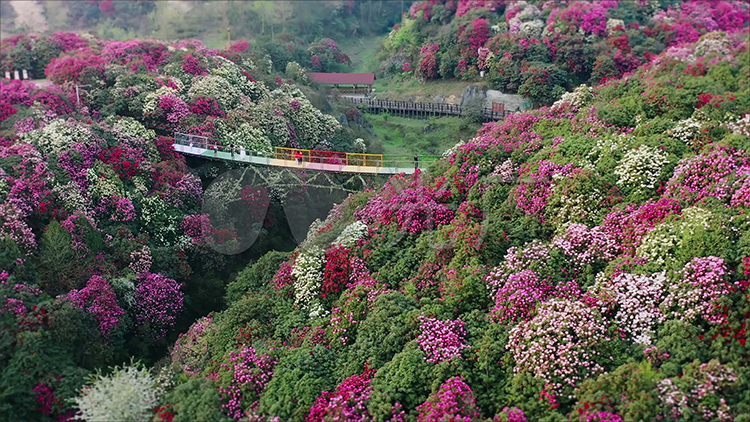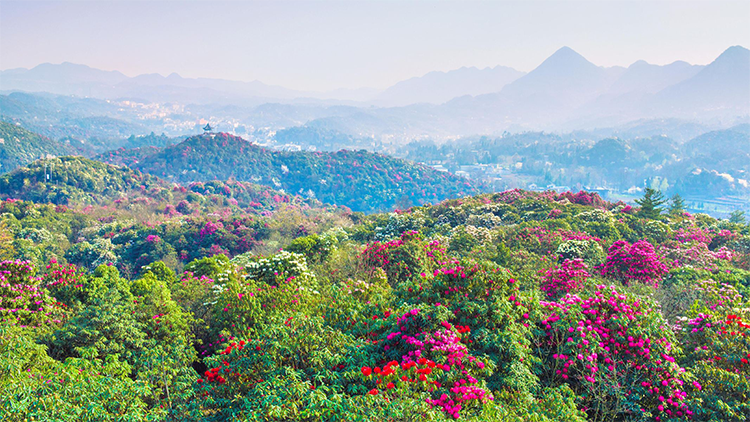Guizhou Spring Travel: Bijie’s Hundred-Mile Azalea Sea in Bloom
Introduction
Imagine a hundred-mile stretch of mountains and meadows ignited each spring by more than 60 wild azalea and rhododendron species—deep crimson Rhododendron simsii cascading like fire, delicate pink-and-white blossoms like fallen stars, and the rare spectacle of “one tree, a thousand flowers” trembling in the breeze. This is not a cultivated park but Bijie’s Hundred-Mile Azalea Sea, the world’s largest natural rhododendron garden. From March to May, 125.8 square kilometers turn into a living palette where Yi flower-rituals and Red Army history add cultural depth to the floral drama.
1. World’s Only Azalea Kingdom
The Hundred-Mile Azalea Sea is China’s only 5A scenic area centered on an original wild azalea forest and holds a Guinness record as the world’s largest natural garden. Unlike planted flower fields, its rhododendrons are wild, ancient trees — the oldest “Azalea King” is over a thousand years old with a trunk that takes three people to embrace. Even more astonishing is the “one-tree-different-flowers” phenomenon: a single plant producing purple, white, and red blossoms simultaneously, a botanical wonder.
2. A Double Feast of Nature and Culture
• Floral spectacle and seasonal shifts
The prime viewing window is from early April to mid-May when core areas such as Jinpo and Pudi roll with waves of blossoms. Morning mists make the branches appear ethereal, while clear skies intensify the colors—photographers can capture striking “flowers and clouds” compositions.
• Yi culture and Red Army legacy
Deep in the park, Yi communities still practice the ancient “flower god” ceremonies, singing and dancing to ask for blessings and good harvests. The land also preserves Red Army history: the Huangjiaba battle site reminds visitors that this floral paradise once bore witness to wartime sacrifice.

3. Practical Deep-Experience Guide
• Hiking and photography routes
For a meaningful visit plan 1–2 days:
– Jinpo Scenic Area: shoot misty flower seas at dawn, stroll wooden boardwalks in the afternoon, and approach the millennial Azalea King up close.
– Pudi Scenic Area: climb for panoramic views of the hundred-mile flower corridor; soft evening light is ideal for portraits.
• How to get there
From Guiyang:
– By car (about 2 hours): drive on the Qian-Da Expressway to the Hundred-Mile Azalea West toll gate. Parking is available within the park.
– By public transport: take a coach from Guiyang Jinyang Bus Station to Qianxi City (approximately 1.5 hours), then transfer to the park shuttle (about 30 minutes).
• Useful tips
– Tickets: peak season admission is ¥130 (covers the full scenic area); seniors over 60 and students pay half price.
– Accommodation: choose Yi-style guesthouses or comfortable hotels near Pudi village to stay close to the blooms.
– Food: try Yi cured pork hotpot and azalea honey; stalls sell local snacks near the park exit.
4. Lesser-Known Ways to Avoid Crowds
Although weekends in April are busy, the park’s vast size helps. To beat the crowds:
– Travel off-peak: visit on weekdays or in early May when flowers remain good but crowds thin.
– Explore secret spots: ask local guides about less-developed areas, such as the primeval azalea woods in Dafang County’s Gamuyu area.

Conclusion
The magic of the Hundred-Mile Azalea Sea is that it’s both a natural marvel and a celebration of life. When millennial rhododendron trees meet Yi songs and Red Army history, the place transcends the label “flower-viewing spot” and becomes an immersive passage through time. If you plan a spring visit to China, add Bijie’s wild azalea sea to your itinerary—where else can you stroll a hundred miles of wild blooms and touch the earth’s ancient pulse?


